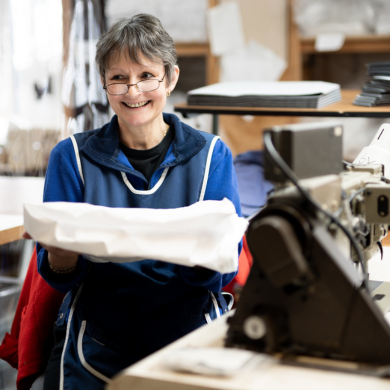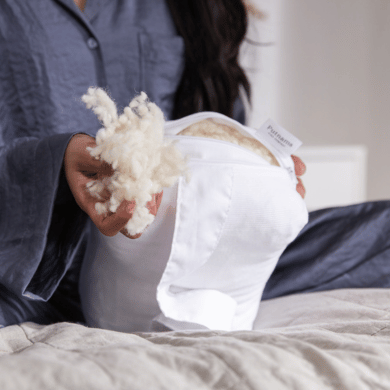
Das Mikro-Nickerchen: Können 10 Minuten wirklich Ihren Tag verändern?
Fällt es Ihnen schwer, in Nachmittagsmeetings wach zu bleiben? Fühlen Sie sich nach dem Mittagessen völlig erschöpft? Damit sind Sie nicht allein. Dieses Mittagstief ist ein weit verbreitetes Problem für vielbeschäftigte Berufstätige, Studierende und Eltern. Doch was wäre, wenn die Lösung nicht eine weitere Tasse Kaffee, sondern eine kurze, bewusste Pause wäre? Hier kommt das Mikro-Nickerchen ins Spiel – ein kurzer Schlaf von nur 5 bis 15 Minuten, der immer mehr Aufmerksamkeit erregt.
Schlafforscher und Produktivitätsexperten untersuchen die Vorteile von Kurzschläfchen. Studien zeigen, dass sie die Aufmerksamkeit deutlich steigern, die kognitive Leistungsfähigkeit verbessern und sogar die Stimmung heben können. In diesem Beitrag beleuchten wir die wissenschaftlichen Hintergründe von Mikro-Schläfern, wie man sie effektiv einsetzt und warum die richtige Körperhaltung und Position entscheidend dafür sind, wie Sie Ihren Nachmittag optimal nutzen können.
Was ist ein Mikro-Nickerchen?
Ein Mikroschlaf ist eine kurze, bewusste Schlafphase von typischerweise 5 bis 15 Minuten. Er dient dazu, der Mittagsmüdigkeit entgegenzuwirken und den Geist zu erfrischen. Dadurch unterscheidet er sich grundlegend von längeren „Powernaps“, die meist 20 bis 30 Minuten dauern und mitunter zu Benommenheit führen können.
Es ist außerdem wichtig, ein kurzes Nickerchen von einem Mikroschlaf zu unterscheiden. Mikroschlaf ist ein unfreiwilliges, nur wenige Sekunden dauerndes Einschlafen, das bei extremer Müdigkeit auftritt, oft ohne dass man es überhaupt merkt. Solche Momente können gefährlich sein, insbesondere beim Autofahren oder Bedienen von Maschinen. Ein kurzes Nickerchen hingegen ist eine bewusste Entscheidung, sich in einer sicheren Umgebung auszuruhen und neue Kraft zu tanken.
Die Wirksamkeit eines Mikroschlafs liegt in seiner Wechselwirkung mit unseren natürlichen Schlafzyklen.
Durch kurze Ruhephasen vermeiden Sie, in die tieferen Schlafphasen zu gelangen. So wachen Sie erfrischt und wach auf, anstatt benommen und desorientiert. Studien zeigen, dass mehr als jeder dritte Erwachsene nicht ausreichend schläft. Daher ist es wichtiger denn je, wirksame Methoden zur Bekämpfung von Tagesmüdigkeit zu finden.
Siehe auch – Mikroschlaf: Die Nickerchen, die nur Sekunden dauern
Die Wissenschaft hinter kurzen Ruhepausen
Die Vorstellung, dass ein zehnminütiger Schlaf vorteilhafter sein könnte als ein längerer, mag zunächst paradox klingen, wird aber wissenschaftlich bestätigt. Studien zeigen, dass sehr kurze Nickerchen die geistige Wachheit effektiver steigern können als längere. Das liegt daran, dass sie für eine schnelle Erfrischung sorgen, ohne die sogenannte „Schlafträgheit“ auszulösen – jenes verwirrte, benommene Gefühl, das man oft nach dem Aufwachen aus dem Tiefschlaf verspürt.
Wenn man länger als 20–30 Minuten schläft, kann das Gehirn in den Tiefschlaf fallen. Das abrupte Aufwachen aus dieser tiefen Schlafphase verursacht die Benommenheit, die dazu führen kann, dass man sich schlechter fühlt als vor dem Nickerchen.
Mikro-Nickerchen umgehen dieses Problem auf clevere Weise komplett.
Die Vorteile gehen über ein bloßes Gefühl der Wachheit hinaus. Kurze Schlafphasen verbessern nachweislich wichtige Gehirnfunktionen, darunter:
- Exekutive Funktionen: Ihre Fähigkeit zu planen, sich zu konzentrieren und mehrere Aufgaben gleichzeitig zu bewältigen.
- Gedächtnisverbesserung: Kurze Nickerchen können helfen, neue Informationen zu festigen.
- Kognition: Ihre allgemeinen Denk- und Problemlösungsfähigkeiten verbessern sich.
Manche Studien legen sogar nahe, dass kurze, regelmäßige Nickerchen positive Auswirkungen auf die Herz-Kreislauf-Gesundheit haben können, indem sie helfen, Stress abzubauen. Eine kurze, bewusste Pause kann außerdem die Stimmung verbessern und dazu beitragen, dass man sich positiver und weniger gereizt fühlt.
Siehe auch – Die militärische Schlafmethode – Ein Zwei-Minuten-Schlafwunder oder nur ein weiterer Hirngespinst?
Wann und wie man ein Mikro-Nickerchen macht
Timing und Technik sind beim erfolgreichen Mikro-Napping entscheidend. Um das Beste aus Ihrer kurzen Auszeit herauszuholen, müssen Sie die richtigen Bedingungen schaffen.
Die optimale Zeit für ein kurzes Nickerchen ist der frühe Nachmittag, typischerweise zwischen 12 und 14 Uhr. Dieser Zeitraum fällt mit dem natürlichen Tiefpunkt des zirkadianen Rhythmus zusammen, dem Zeitpunkt im Tagesverlauf, an dem das Energieniveau naturgemäß abnimmt. Ein Nickerchen in dieser Phase unterstützt den natürlichen Biorhythmus, erleichtert das Einschlafen und sorgt für ein erfrischtes Aufwachen.
Hier die Schritte für ein effektives Mikro-Nickerchen:
- Finden Sie die richtige Umgebung: Suchen Sie sich einen ruhigen, dunklen und kühlen Ort. Das kann ein Einzelbüro, ein ruhiger Pausenraum oder sogar Ihr Auto sein. Je weniger Ablenkungen, desto schneller können Sie sich entspannen.
- Machen Sie es sich bequem: Sie brauchen kein Bett. Ein bequemer Stuhl oder ein Relaxsessel mit guter Stütze ist oft ideal. Wichtig ist, dass Sie eine Position einnehmen, in der Sie Ihre Muskeln vollständig entspannen können.
- Stellen Sie einen Wecker: Das ist entscheidend. Stellen Sie einen Wecker auf 10–15 Minuten. Zu wissen, dass Sie eine Frist haben, hilft Ihnen, abzuschalten, da Sie sich keine Sorgen machen müssen, zu verschlafen.
- Entspannen Sie sich: Setzen Sie sich nicht unter Druck, sofort einschlafen zu müssen. Konzentrieren Sie sich auf tiefe, langsame Atmung oder hören Sie beruhigende Musik. Selbst wenn Sie nicht vollständig einschlafen, kann es unglaublich erholsam sein, einfach nur 10 Minuten lang die Augen zu schließen und den Geist zur Ruhe kommen zu lassen.
Wenn Sie Schwierigkeiten beim Einschlafen haben, keine Sorge. Regelmäßigkeit hilft. Indem Sie versuchen, jeden Tag zur gleichen Zeit ein kurzes Nickerchen zu machen, können Sie Ihren Körper daran gewöhnen, diese Zeit als Ruhepause zu erkennen.
Die Rolle der Körperhaltung bei der schnellen Genesung
Ihre Körperhaltung während eines Kurzschlafs hat einen erheblichen Einfluss auf dessen Erholungswirkung. Wenn Sie über Ihrem Schreibtisch zusammensacken oder sich auf einem kleinen Sofa verrenken, kann dies zu Verspannungen in Nacken und Wirbelsäule führen und den Erholungseffekt zunichtemachen. Die richtige Unterstützung und Ausrichtung sind daher entscheidend für eine optimale Regeneration.
Wenn Sie sich ausruhen, sollten Ihre Muskeln vollständig entspannen.
Eine gute Körperhaltung ermöglicht dies und beugt den körperlichen Belastungen vor, die durch eine schlechte Haltung entstehen. Indem Sie Nacken und Wirbelsäule stützen, vermeiden Sie, mit einem steifen Nacken oder Rückenschmerzen aufzuwachen.
Diese Konzentration auf die Körperhaltung trägt direkt zum allgemeinen Wohlbefinden und zur Produktivität am Arbeitsplatz bei. Eine erholsame Pause ohne körperliche Beschwerden ermöglicht es Ihnen, erfrischt und mental wie körperlich an Ihre Aufgaben zurückzukehren. Nehmen Sie sich einen Moment Zeit, um sicherzustellen, dass Sie gut gestützt sind – so wird aus einer kurzen Pause eine wirkungsvolle Erholungsmaßnahme.
Siehe auch – Das Paradoxon des Mittagsschlafs: Sind Mittagsschläfchen Freund oder Feind?
Produkte, die Mikro-Nickerchen erleichtern
Eine angenehme Umgebung für ein kurzes Nickerchen zu schaffen, insbesondere im Büro oder auf Reisen, kann eine Herausforderung sein. Die richtigen Hilfsmittel können den Unterschied zwischen einer unruhigen, unbequemen Pause und einem wirklich erholsamen Kurzschlaf ausmachen.
- Putnams Bürokissen : Für alle, die eine kurze Pause am Schreibtisch einlegen, bietet ein ergonomisches Bürokissen die notwendige Unterstützung für den unteren Rücken und hilft Ihnen, auch beim Sitzen eine gesunde Körperhaltung beizubehalten.
- Putnams Keilkissen: Wenn Sie Zugang zu einem Bürostuhl haben, ist ein Keilkissen ideal.
- Putnams Reisekissen: Für kurze Nickerchen unterwegs, sei es im Zug auf dem Weg zur Arbeit oder auf einem Langstreckenflug, ist ein hochwertiges Reisekissen unverzichtbar. Es bietet die notwendige Nackenstütze, um Verspannungen vorzubeugen, und ermöglicht bequemes Liegen in aufrechter Position.
Die Verwendung dieser Produkte hilft dabei, einen eigenen Raum der Ruhe zu schaffen und dem Körper zu signalisieren, dass es Zeit ist, abzuschalten und sich zu erholen.
Bewährte Praktiken für kurze Nickerchen am Arbeitsplatz
Die Vorstellung, am Arbeitsplatz ein Nickerchen zu machen, mag noch immer tabu erscheinen, doch die Einstellung ändert sich, da immer mehr Unternehmen den Zusammenhang zwischen Erholung und Produktivität erkennen.
Wenn Sie kurze Nickerchen in Ihren Arbeitsalltag einbauen möchten, sollten Sie dabei diskret vorgehen und die Unternehmenskultur respektieren.
Suchen Sie sich während Ihrer Mittagspause einen geeigneten Ort, zum Beispiel ein leeres Büro, einen dafür vorgesehenen Ruheraum oder sogar Ihr Auto. So vermeiden Sie, Kollegen zu stören, und haben die nötige Privatsphäre zum Entspannen.
Wenn Sie sich damit wohlfühlen, sollten Sie ein Gespräch mit Ihrem Vorgesetzten in Erwägung ziehen.
Stellen Sie Produktivität und Wohlbefinden in den Vordergrund und erklären Sie, dass eine kurze, zehnminütige Pause Ihre Konzentration und Energie für den Nachmittag deutlich steigern kann. Viele zukunftsorientierte Unternehmen, darunter Branchengrößen wie Google und Nike, fördern bereits kurze Pausen, da sie deren positiven Einfluss auf die Leistung und das Wohlbefinden ihrer Mitarbeiter beobachtet haben.
Siehe auch – Ruhepausen am Arbeitsplatz – Gov.uk
Verwandle deine Nachmittagsenergie
Das Kurzschläfchen ist mehr als nur ein kurzlebiger Trend; es ist ein wirksames, wissenschaftlich fundiertes Mittel, um die Energie zu regulieren und die geistige Leistungsfähigkeit zu steigern. Für vielbeschäftigte Berufstätige, Studierende und Eltern bietet es eine praktische Möglichkeit, der Nachmittagsmüdigkeit entgegenzuwirken, ohne den Tagesablauf zu stören.
Eine kurze, bewusste 10-minütige Pause kann sich tatsächlich deutlich auf Ihre Konzentration, Ihre Stimmung und Ihre Produktivität auswirken.
Indem Sie die wissenschaftlichen Grundlagen verstehen, den richtigen Zeitpunkt finden und für eine angemessene Körperhaltung sorgen, können Sie das volle Potenzial des Mikro-Nickerchens ausschöpfen.
Probieren Sie es doch einfach mal aus! Wir empfehlen Ihnen, eine Woche lang mit Mikro-Napping zu experimentieren. Suchen Sie sich nachmittags einen ruhigen Moment von 10 Minuten, machen Sie es sich bequem und spüren Sie den Unterschied.
Vielleicht entdecken Sie darin genau die Geheimwaffe, die Sie brauchen, um das Nachmittagstief zu überwinden.
Häufig gestellte Fragen
Kann man von einem 10-minütigen Nickerchen wirklich profitieren?
Ja, absolut! Studien belegen, dass ein kurzes, zehnminütiges Nickerchen die Aufmerksamkeit, die kognitiven Fähigkeiten und die Stimmung verbessern kann. Durch die kurze Dauer profitiert man von der Erholung, ohne in einen Tiefschlaf zu fallen, wodurch die Benommenheit, die mit längeren Nickerchen einhergeht, vermieden wird.
Wie lange sollte ein Nickerchen idealerweise dauern, um Energie zu tanken?
Für einen schnellen Energieschub ist eine Nickerchendauer von 10 bis 15 Minuten ideal. Das ist lang genug, um sich erholsam zu fühlen, aber kurz genug, um nicht in den Tiefschlaf zu fallen. So wachen Sie erfrischt und voller Tatendrang auf.
Helfen kurze Nickerchen?
Ja, das stimmt. Kurze Nickerchen sind wissenschaftlich erwiesen ein wirksames Mittel gegen Müdigkeit. Sie können das Gedächtnis verbessern, die exekutiven Funktionen steigern und die Gesamtproduktivität erhöhen – ein wertvolles Hilfsmittel für alle mit einem anspruchsvollen Zeitplan.
















Hinterlassen Sie einen Kommentar